Review Overview
- Setting8
- Characters9
- Story8
- Animation9
- Sound9
Cowboy Bebop is a definition of what anime was back in its day and what it can achieve. I've yet to find someone who utterly disliked it
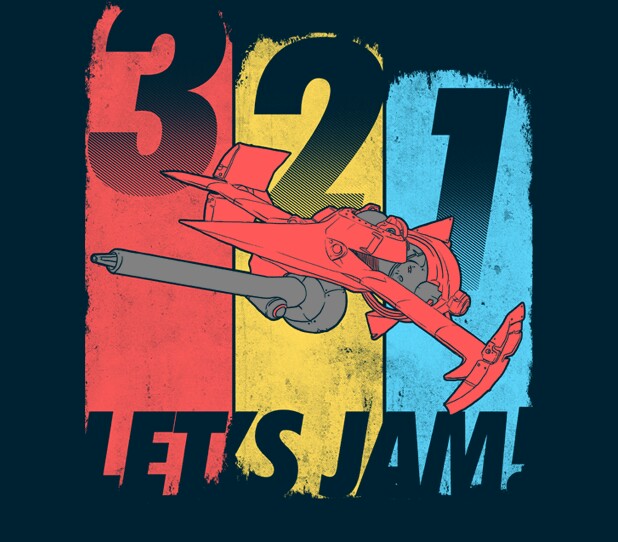
Flawless individuality is always wished from an anime. However, a show that is true perfection is yet to be brought into existence, though Cowboy Bebop in many ways displayed a glimpse of what it could be.
With its distinguished visual style, each episode is treated as a miniature film or a standalone session as we learn.
The show was originally canceled on TV Tokyo, but they soon came to realize its depth and the beauty it held. Later Bebop was shown in its entirety from Oct 24, 1998, to April 24, 1999, on WOWOW channel while the anime established itself as a gateway to introduce anime to the West. From being influenced by martial arts to various philosophical concepts, this “Star Wars of anime” has proven not only to be inspiring but also a portrayal of what an anime is capable of.
Setting
The year is 2071 and with the invention of hyperspace gate technology, mankind is now wandering through the galaxy. But when criminals become too elusive for the cops they need the help of a good old-fashioned cowboy.
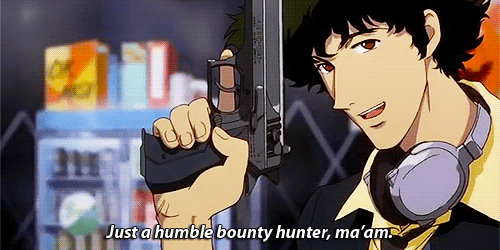
Rating: The settings were vast yet usually explored within our solar system around Mars, Earth, and Jupiter for most of the time. Japan sure loves Mars and Jupiter more than other planets as is evident through many a classic sci-fi series in the past. With that in mind, a score of 8/10.
Characters
Too many characters often create flaws in characterization. Cowboy Bebop resolved it by simply eliminating the necessity and giving enough distinct characteristics to almost each recurring character it has in it. All characters are played straight in this series at a time when they were usually designed to overact; as the norm was in those days, not to say that there isn’t some measure of a much appreciated upbeat humor.

- Spike Spiegel: A martial arts expert and a skilled Shooter with an outfit of Lupin III based on the appearance of Japanese actor Yuusaku Matsuda, mostly seen in his famous television show — Tente Monogatari. Previously associated with a highly prominent criminal syndicate, Spike’s past often comes back to haunt him in nearly every step of his way. His greatest trait is how he is able to switch his attitude depending on the situation and not be bogged down even when things get rough, unlike many protagonists of modern times. This part of him that shows how he stays ahead of the curve against the competition makes him a really likable character that fans quickly take a strong liking to. His eyes were designed to show his pain and suffering. The dark clothing color scheme of Spike’s suit is intended to reflect his state of mind. Director Toshihiro Kawamoto first designed Spike and then constructed the whole story around him. That makes him the center of everything in the story. One is always deceived by Spike’s lazy lying-around figure, that hides a Bruce Lee within it.
- Jet Black: A former cop and one of the more straightforward characters, Jet acts as a guardian for the crew. He deals with the business side of things as well as ship maintenance, situation analysis and holding the biggest contact book (in the galaxy?) with outside agencies for information on their various targets. Jet is the total opposite of Spike and is the voice of reason. With three other characters running around doing what they want, Jet brings them together and holds the team.
- Faye Valentine: Frozen in a cryotank, this 77-year-old infamous femme fatale tops the list of a lot of peoples’ sexiest anime characters. Unlike Jet and Spike, Faye tries to find her way through her past, but eventually loses herself sometimes on gambling and excessive greed. She can be vulnerable, adding much to her character but it is her sassy attitude that always keeps her entertaining and alluring.
- Edward (Edward Wong Hau Pepelu Tivrusky IV): A super-hacker from Earth, Edward joins the crew because she thinks it will be fun. Ed exists in the story to lighten the mood and add contrast. Her childish black-and-white attitude is much needed, otherwise, the show would spend far too long on the darker side of characterization.
- Secondary characters: Secondary characters are the threshold of background details. Bebop’s secondaries are simple yet involved as much as they tend to be. Most new episodes have a new character who are introduced and developed to quite a fair depth in just a ~25 min time slot. Same goes for some of the recurring characters, featured below; three old guys and two actors are big shots in what they do. They never get in the way of storytelling but have enough screenplay to be memorable in their own special way.
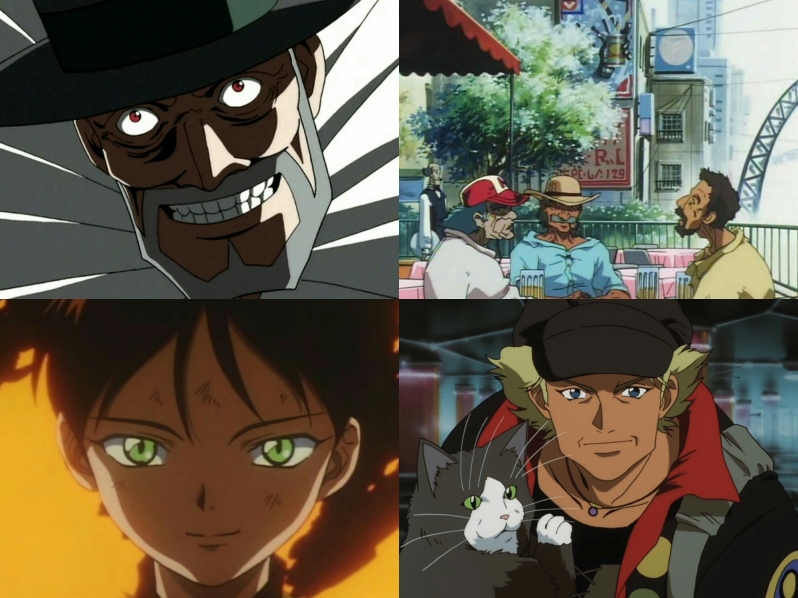
Rating: Primary and secondary characters have enough grip to be individuals on their own. 9/10 for making each character memorable.
Story
The overall plot is simple enough to grasp yet holds the throne of being one of the most entertaining and interesting plots in anime. “Extremely skilled crew often suck at their job”, is quite possibly the main plot point of the series. Being an episodic anime, Cowboy Bebop‘s one major shortcoming is its slow start, which was one of the reasons for cancellation; some industry experts say. Yes, it is quite true that Bebop doesn’t get interesting until episode 5, ‘Ballad of the fallen angel’. Considering its reputation, episodes 1-4 were weak at introduction. Not that they sucked or anything but they didn’t represent the strong points of the show. Even for a show of its time, there were limited viewers who would have patience to hang on until episode 5 to know where the story was headed. A lot of people these days would immediately drop off a show at episode 1 if it didn’t perform. Through an exchange of information from one fan to a potential viewer, many people often end up starting from episode 5 and 6 and then head back to episode 1. Episode 5 and 6 have enough context for introduction and also make the first four episodes more entertaining.
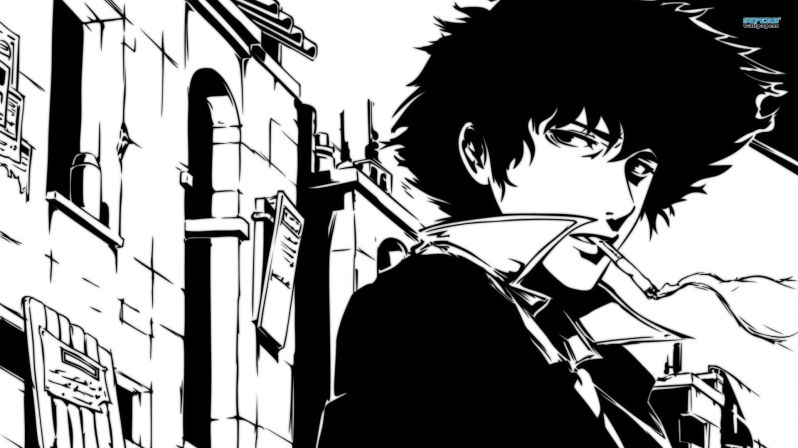
- Influence/inspirations: The story is highly influenced by particular films like Django (1966, the original) and Enter the Dragon (Spike’s fighting style based off Bruce Lee). Desperado, The Crow, Reservoir Dogs and Better Tomorrow being some of the other prominent notable examples. Ed’s chess moves are real moves that the famous chess player Paul Morphy played. George Herman Ruth’s name was broken down to make three names of side characters. Data’s cryotank number NCC-1701-B was taken from Star Trek. Many character names were taken from famous musicians. And that is why the beauty is in the details of this show, something not many other shows possess.
Rating: 8/10 for its simple yet deep-as-an-ocean story.
Animation
Bebop’s animation is phenomenal for its time and still stands up to today’s shows even though it was one of the last anime to be made using the traditional style of cel animation, which is just a testament of its fluid animation having the same quality as digital animation with each keyframe drawn by human hands.
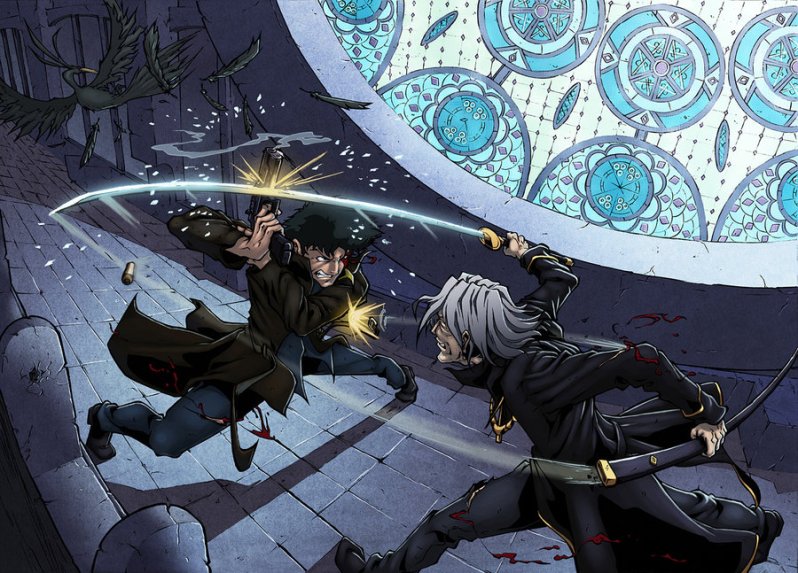
- Officially Cowboy Bebop was animated by SUNRISE, creators of the meta-series of Gundam. However, it is believed by many to be created by the staff of studio BONES, a studio that is known for its high production values. Guess what, a large chunk of SUNRISE staff at one point left to create their own production company BONES.
Rating: 9/10 for its stellar standards in animation.
Sound
Yoko Kanno is one of the best in her field, and her work in Bebop has introduced jazz and blues to the majority of anime fans since it was made. It’s a show that swims through music with a multitude of genres that swing from episode to episode. Most of the titles are even musical references like Rolling Stone’s ‘Honky Tonk Women’, Queen’s ‘Bohemian Rhapsody’, etc.
The opening theme “Tank”, is in a class all of its own with a blending of genres containing a big band jazz piece performed in a latin hard bop style with a rhythm that combines both double bass and bongo drums. The intro voice was Tim Jensen’s.
- Dubbing: The dubbing has basically been the benchmark of every classic anime introduced to the west. The show has some of the most memorable performances with vocals by Steve Blum, Wendee Lee and Melissa Fahn with voice direction by the great Mary Elizabeth McGlynn herself.
- Dialogue: A topic such as this is vulnerable in a review yet Bebop as a classic played many memorable lines that echo whenever anyone hears its name.
- Rating: So with that been said Cowboy Bebop‘s soundtracks deserve no less than 9/10.
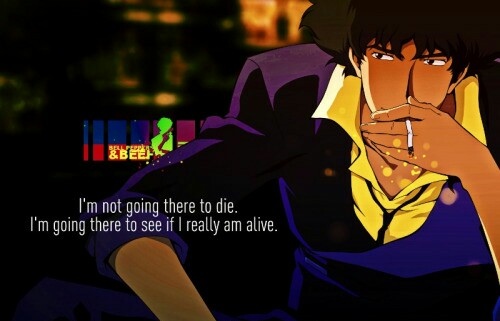
Summary
Cowboy Bebop is a definition of what anime was back in its day and what it can achieve. I’ve yet to find someone who utterly disliked it or hasn’t found something of value from this classic visual phenomenon. Therefore, to summarize the whites and blacks …
Temptations:
- An absolute classic.
- Vast and detailed settings and backgrounds.
- Mesmerizing soundtracks from Yoko Kanno.
- Each character has their own vibes.
- The animation is fluid as water.
Flaws:
- The crew is unable to turn in the Bounty on their targets on 14 separate occasions, some viewers tend to get bummed at something of this nature.
- Most of the time the story takes place on Mars. Almost entirely limited to our solar system.
- A slow start and initially weak introduction.
Flaws notwithstanding, Cowboy Bebop is a must watch anime with an R-17 rating.

Finalized score for Cowboy Bebop is 8.6/10





